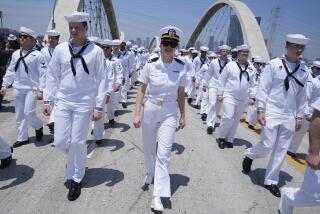Crew Work
- Share via
If any child in your family has ever entertained the urge to run away to sea, here’s a way to check out the idea. We’re not talking about joining the modern high-tech U.S. Navy, by the way. No, the fantasy in question here is the old-fashioned, 1792 model--where the ships are wooden with sails hoisted by ropes, by hand, by you. Sorry, no push-button modern conveniences.
Beginning today, until March 1, young visitors to Ventura Harbor Village will be able to board a couple of “tall ships,” named Mary Washington and Hawaiian Chieftain, and find out what life was really like at sea during the Golden Age of Sail.
For the past few years, this pair of ships, built in the 1980s following designs of 200 years ago, has been making annual visits to the California coast.
Docking in Ventura, San Diego, Los Angeles and San Francisco--among other ports--the ships’ crews, in period costume, conduct educational programs. They also offer short excursions, which sometimes include reenactments of old-fashioned naval gun battles.
Parents are invited to take kids for visits on board Saturdays and Sundays, but the most frequent young visitors have been from fourth-grade classes, which take field trips during the school week. California kids are required to study state history in the fourth grade, and jump at the chance to go on board a ship for a glimpse of sailing life back when American trading ships began visiting the ports of Spanish California.
Jamie Stopher, a fourth-grade teacher at Grace Brethren Elementary School in Simi Valley, has booked a tour for 90 kids. The veteran visitor to the ships predicted, “They will be amazed to discover how heavy the ropes are when they get a chance to hoist the sails.”
“They learn that sailing wasn’t a pleasure cruise, but a lot of hard work and danger.”
It has been her experience that once her young coeds have worked up a sweat setting the rigging, “It’s the girls who remark about how hard it was. The boys are too proud to let on.” But the girls get upset when they discover that, in the 1700s, they would not have been allowed to join a sailing crew.
Today’s girls are included in every aspect of the ship-board experience, said the captain of the Hawaiian Chieftain, Ian McIntyre. He puts all of his young visitors through a short course in “line handling,” mentioned above, plus navigational techniques (using period equipment) and an explanation of trading practices in the 1700s.
“In exchange for manufactured goods, the Spanish gave the Americans steer hides and the Indians gave abalone shells,” he said. “The Americans then sailed north and gave abalone shells to the Northwest Indians in exchange for otter pelts. Then they sailed to China to exchange the pelts for fine china. Then back to the U.S., where they sold the hides and chinaware for cash to buy more manufactured goods to take back to California.”
Stopher, like many teachers who bring kids to visit the ships, asks them to write an essay on “The Life of a Sailor.” Last year, at the end of one essay that mostly dwelt on a sailor’s difficult working and living conditions on long journeys, came the observation: “. . . but at least they didn’t have to go to school.”
BE THERE
Tours--Tall ships Lady Washington and Hawaiian Chieftain will be at Ventura Harbor Village, 1559 Spinnaker Drive, Ventura, from Feb. 19-March 1. Visit aboard ships, $7 per family, $3 adults, $2 student/senior, $1 child, 4-6 p.m. weekdays and 10 a.m.-1 p.m. Saturdays. Sailing trip and battle reenactment, Saturday 10 a.m. or Sunday 10 a.m.-1 p.m. and 2-5 p.m. $25 kids, $40 adults; for general information, call (800) 356-2972.
School groups--One-hour programs on ships at dockside weekdays from 3:30-6 p.m.; 30-person minimum, $5 per person. School-group sailing voyages lasting three hours cost $30 per person. Call (800) 401-7835.
More to Read
Sign up for The Wild
We’ll help you find the best places to hike, bike and run, as well as the perfect silent spots for meditation and yoga.
You may occasionally receive promotional content from the Los Angeles Times.






